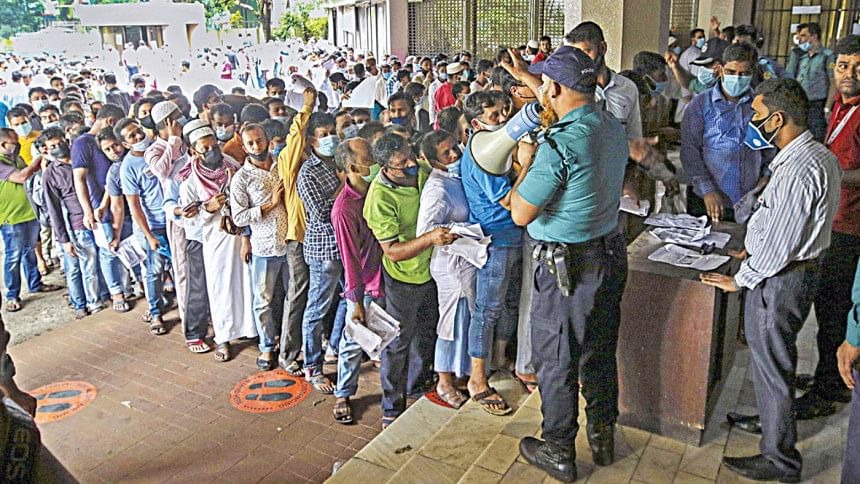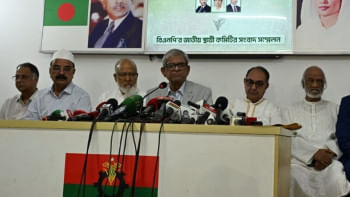High cost of migration and the woes of our workers

The importance of international migration in Bangladesh can hardly be overemphasised. Bangladeshis constitute the fifth largest migrant community in the world. Migration has consistently remained a key source of foreign exchange (bringing in more than USD 18 billion in 2019) and job creation (employing more than 8 million or roughly 11 percent of the Bangladeshi workforce). It is certainly key to the steady economic growth of the country. Migration is also a viable option for many, especially the underprivileged youth, to change their life trajectory. On average, migrant households earn twice as much as the non-migrant households, a 2010 study by the International Organization for Migration (IOM) found.
But the cost of migration from Bangladesh is unusually high—it is actually considered one of the highest in the world. It is a long-standing issue. More than a decade ago, a Bangladeshi migrating to the Middle East paid an amount equivalent to USD 3,000 on average, which was two to four times higher than the cost for the migrants in neighbouring countries including India, Pakistan, Nepal, and Sri Lanka. The situation has barely changed over the years. A male migrant, interviewed by the BRAC Institute of Governance and Development (BIGD) for a 2017 study on migration vulnerabilities, recalled being ridiculed by his Nepali colleagues for paying an exorbitant amount for migration, four times as high as what they paid for the same job. The BIGD's 2020 survey among returnee migrants found that 40 percent paid an equivalent of USD 3,500 or more for their latest migration.
The high cost of migration has several negative consequences for the workers and their families. Low- and semi-skill and, to some extent, high-skill blue-collar jobs in the Middle East are the most sought-after ones for Bangladeshis. These jobs are most appealing to the youth coming from poorer socioeconomic backgrounds, because they cannot earn enough to change their fate from similar types of jobs in their country, nor do they have the right education and skills to find better overseas employment. Left with limited options, they often resort to selling their assets and borrowing from friends and family as well as moneylenders. It makes them vulnerable in many ways.
Remittance is the main source of income for most migrant families. This was apparent in the BIGD 2020 survey among the returnee migrants, which found that 92 percent of migrant families had a monthly income of more than BDT 20,000 when the migrants were working abroad, and the figures completely flipped after their return. This implies that most migrants fully support their families alongside paying back their loan.
The high cost of migration combined with family needs and the repayment burden put the migrants in a stressful situation, which is exacerbated by the generally low income of Bangladeshi migrants. A 2017 BRAC survey found that most workers in the Middle East were paid a monthly salary of around Tk 20,000 only, and very few were paid Tk 40,000 or higher. Consequently, it often takes them years to finish repaying and start investing in productive assets. That is why, the 2020 survey found that 40 percent of returnee migrants had absolutely no source of income after returning. The high cost thus substantially curtails the long-term welfare enhancing potential of the migrants and their families.
The high cost is not merely of economic consequence, however. It also exposes the migrants to other forms of vulnerabilities. Desperate to recover the investment and repay the loan, migrants are forced to hold on to their jobs even when the work environment is abusive and precarious, which is often the case. For the same reason, many take the risk of illegally changing jobs when they find that their salary is too low, or the working conditions are unfavourable. Sometimes men get involved in illegal activities out of desperation to earn extra money. In the 2017 BIGD study, a female migrant commented, "I worked at a hospital in Saudi Arabia for two and a half years. After the hospital closed, my employer offered me a return ticket or a job as a domestic worker. I thought, since I spent so much money to come here, let me stay back. But oh, the kind of work and treatment I got in that house! There were 16-17 children in the house, and I had to do all the work."
The situation is particularly problematic for poorer migrants. They have the greatest need to turn around their economic reality, yet they fall in the most stressful situation. Because they have limited means, they are more likely to borrow, borrow more, and borrow from moneylenders at a high interest rate. Because of their lower skills, they are more likely to earn less abroad. Because of their poverty, they are more likely to be financially responsible for their families. They are even more likely to pay higher for migration because it is easier to cheat them.
Why is the cost of migration so high in Bangladesh? The answer perhaps lies in the chaotic migration process of the country.
Involvement of multiple intermediaries in the process is a crucial factor. Recruitment agencies are based mainly in Dhaka and rely on middlemen or dalals to recruit potential clients. A potential migrant goes through multiple middlemen, often four or five of them. Every one of them adds to the cost of the migrant. By the time potential migrants reach a recruitment agency, they may have spent lakhs of taka. The cost of intermediation is steep, 59-75 percent of the overall cost, according to different estimates.
The involvement of multiple middlemen also makes it easier to dodge accountability, deliberately obfuscate information, and even cheat. Because of this, it is almost impossible to get the money back if potential migrants change their minds. About a third of those who try to migrate fail and incur an average monetary loss exceeding USD 818, finds the 2017 BRAC study.
It would be unjustified to assume that intermediaries are pure evil and add no value. They perform an important function as the recruiters do not find it financially viable to get directly involved in the recruitment process. Intermediaries can take advantage of that because there is no other viable alternative and migration is a complicated process, which most potential migrants know nothing about.
But according to the Overseas Employment and Migrants Act 2013, the recruiting agencies are supposed to select aspiring migrants from the list prepared by the Bureau of Manpower Employment and Training (BMET). However, the database is not complete or updated, and thus not very useful. Today's digital technology offers many innovative and viable solutions for managing an updated and useful nationwide database of aspiring migrants. When or if it is made available, the intermediaries are likely to become largely redundant. A centralised database will also bring more transparency to how the recruiting agencies deal with the migrants.
"Facilitating orderly, safe, and responsible migration and mobility of people, including through implementation of planned and well-managed migration policies" is the SDG that the government of Bangladesh has signed up for. Reducing the cost of migration falls squarely into its scope. It is not only about increasing the migrants' economic welfare but also about amending the injustice that our migrants have been facing for so long.
Nusrat Jahan is Head of Business Development and Knowledge Management, BIGD, BRAC University.

 For all latest news, follow The Daily Star's Google News channel.
For all latest news, follow The Daily Star's Google News channel. 



Comments